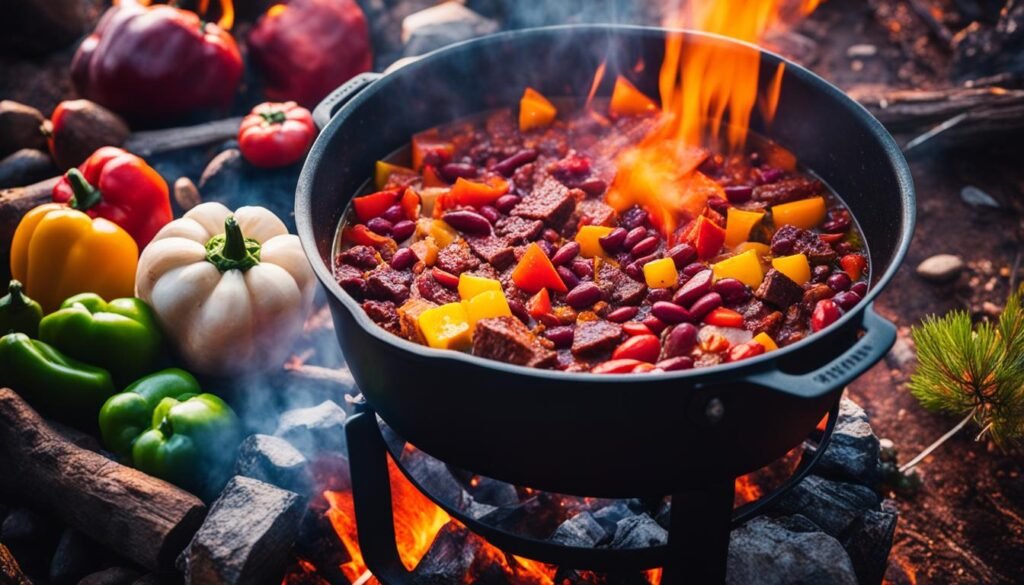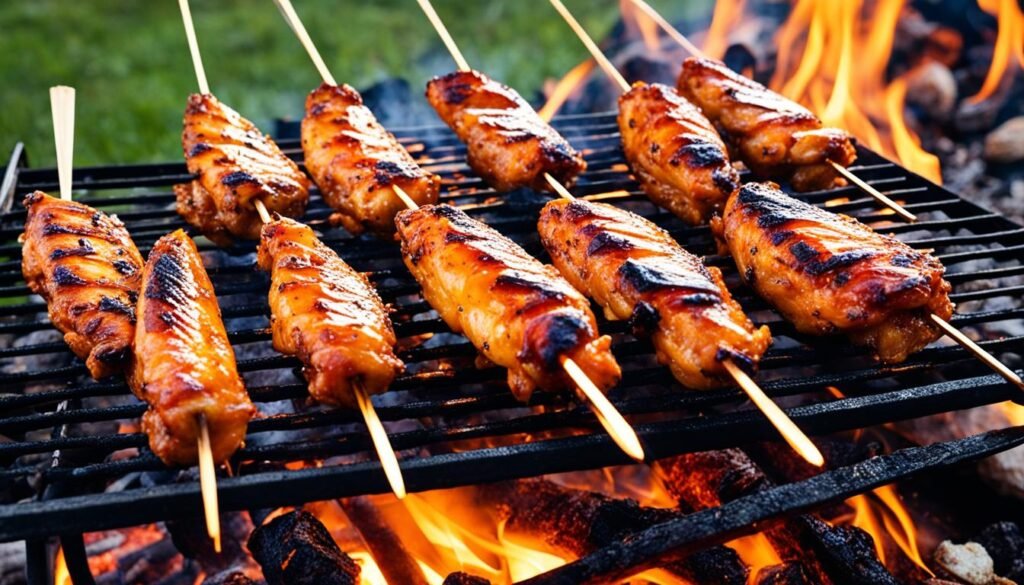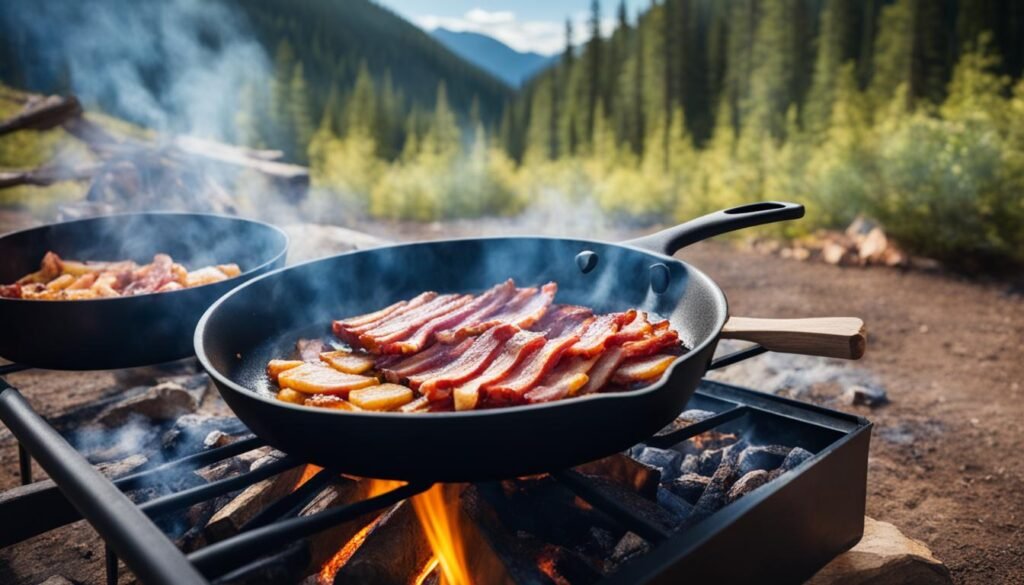Whenever I reflect on those cherished moments spent in the embrace of nature, they are often accompanied by memories of a rustic chili simmering over a campfire. This beloved recipe, passed down from friends and perfected through many a camping trip, speaks to the essence of outdoor culinary adventure. A bowl of savory, slow-cooked chili represents more than just a meal; it’s a ritual that brings warmth and comfort to cool fall nights under a starlit sky.
There’s an art to crafting the perfect campfire chili recipe, one that ingeniously blends local ingredients with the smoke-kissed flavor that only an open fire can impart. My forays into the wilderness are always accompanied by this dish, prepared with meats lovingly sourced from The Heart & Trotter in North Park—a butchery known for its commitment to local and responsible sourcing. Paired with an array of vibrant spices and robust beans, my campfire chili is not just delicious; it’s an ode to the power of simple, authentic cooking.
So, how do you bring this delicious campfire meal to life? Follow along as I share not just a recipe, but a guide to creating easy campfire recipes that comfort the soul and feed the spirit of adventure. Whether gathered around the flames with old friends or making new memories, this chili is a testament to the timeless joy of campfire cuisine.
Key Takeaways
- Understanding the art of how to cook chili over a campfire enhances the camping experience.
- A rustic chili recipe is the perfect way to connect with nature through comfort food.
- Quality local ingredients make a campfire chili recipe not just tastier but more sustainable.
- Preparation is key to easy campfire recipes, enabling more time to soak in the wilderness.
- Delicious campfire meals, like chili, provide both nourishment and warm companionship.
- Simple techniques bring out rich, smoky flavors that define an authentic campfire cooking style.
Embracing the Great Outdoors with Hearty Campfire Cuisine
As I breathe in the crisp, wood-scented air of the wilderness, my thoughts turn to the comfort of a steaming hot bowl of chili. This is not just any chili, but one prepared with the pride of outdoor culinary skills, simmering patiently over a campfire. I’m reminded that the perfect meal to share under the expanse of the stars is one that not only satisfies hunger but also enriches the soul—a meal best embodied by a pot of chili cooked over an open flame.
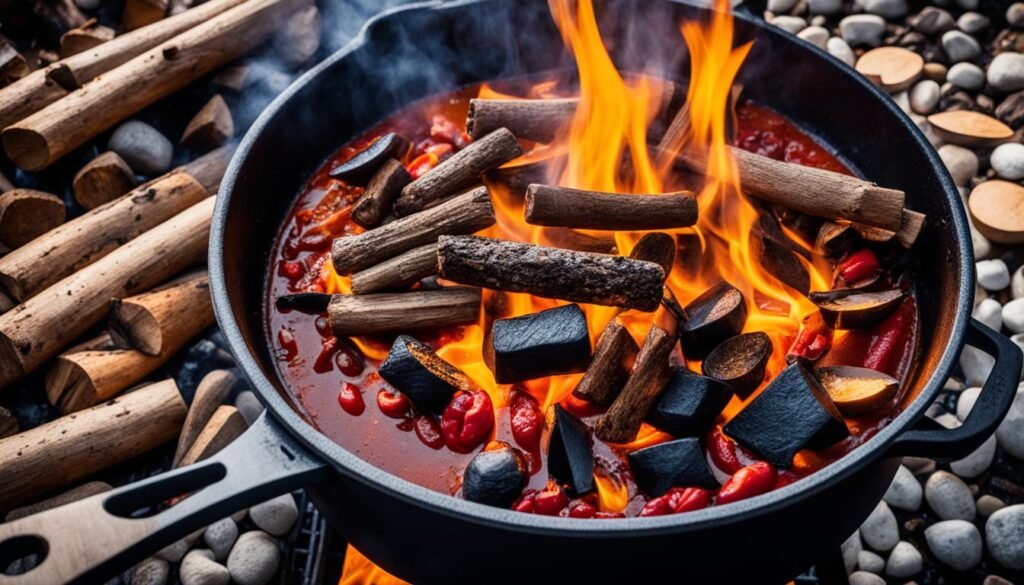
Why Chili is the Perfect Camping Meal
Chili has long been revered as the ultimate camping fare, a dish that provides both the warmth needed on chilly evenings and the hearty sustenance to refuel after a day of adventure. The process of learning how to cook chili over a campfire enhances one’s outdoor experience, infusing the dish with a unique smokiness that cannot be replicated in any kitchen. It’s a culinary tradition that carries the torch of campfire legends, revered not just for its bold flavors but for its ability to unify a circle of campers.
Benefits of Outdoor Cooking
The merits of outdoor cooking are as vast as the landscapes we explore. When we undertake the task of campfire cooking, we often expect more than just a meal—we seek an experience. Not only does it offer us the best chili for camping, hearty and rich, but it also bestows upon us the benefits of engaging with nature. To cook over a campfire is to part ways with the digital world, welcoming a sensory awakening that reconnects us with the earth, the crackling fire, and the fresh ingredients at our fingertips. The camaraderie built as we share campfire cooking techniques and stories enhances the meal’s flavor, and the shared responsibility of cooking together fosters a deeper bond among companions.
- Introduces a rustic and rich flavor to dishes, unattainable through conventional cooking methods
- Encourages mindfulness and presence, rooting us firmly in the ‘now’ of the natural surroundings
- Invigorates the senses and expands our cooking repertoires with diverse outdoor cooking tips
- Provides the joy of creating something from scratch in a world that is increasingly pre-packaged
It’s no wonder that each trip to the wilderness is accompanied by an eager anticipation to fire up the flames and indulge in the best chili for camping—a dish that, for all intents and purposes, equates to a bowl of happiness under the stars. So join me as we dive into the smoky allure of campfire cuisine, rich with tradition, festivity, and the very essence of adventure.
Essential Ingredients for a Rustic Chili Recipe
When my adventures lead me to the great outdoors and the night air begins to cool, there’s nothing like the experience of chili cooking over open flame. The crackle of the campfire, the aroma of spices mingling with the fresh air—it’s not just a meal, it’s a moment. Crafting the perfect rustic chili recipe begins with selecting the right ingredients to withstand the heat of the coals and to enrich the pot with layers of flavor.
Envision the chili as a tapestry of taste—a combination of meats, vegetables, spices, and liquids—all woven together by the gentle, smoldering heat of a campfire. As the cornerstone of a manifold of campfire chili recipes, the quality of ingredients cannot be overstated. Sourcing meats like lamb shoulder and chorizo from The Heart & Trotter, I ensure the chili’s foundation is robust and ethical.
To this meaty canvas, add the vibrant colors of aromatics and spices: onions, carrots, and a medley of peppers provide a fresh crunch and kick—the likes of bell peppers, jalapenos, and poblanos. The dimensions deepen with a generous dusting of paprika and ancho chile powder, summoning a smoky essence that feels right at home amid the flickering flames.
The symphony of flavors continues as beans enter the fray—black beans and kidney beans, rinsed well, bring heartiness and texture that cling to every spoonful. As for the liquid elements, a dark, malty beer infuses the chili with a complexity that water alone could never impart, while a rich beef stock unites all components in a harmonious broth.
To bring this dish to fruition, a cookware essential—the trustworthy Dutch oven—is a must. Together with crushed tomatoes to add body, and a dash of salt and pepper for seasoning, this rustic chili recipe is poised for simmering under the stars.
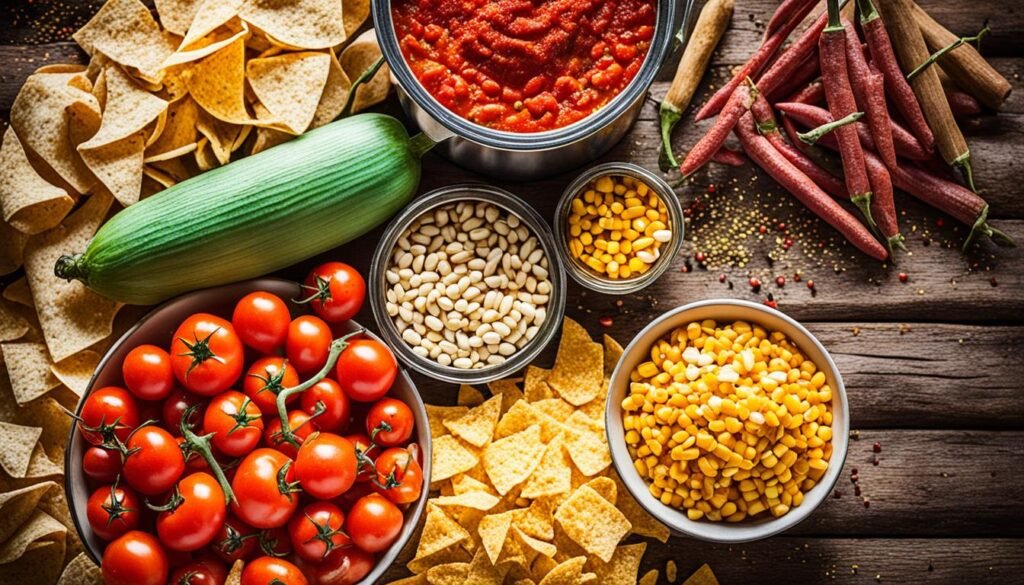
To illustrate the harmony of ingredients and their camping suitability—an indispensable guide for your upcoming culinary adventure—see below:
| Ingredient | Quantity | Notes |
|---|---|---|
| Lamb Shoulder | 1 lb | Rich in flavor, ideal when cut into 1-inch cubes |
| Chorizo | 1 lb | Adds a spicy, fatty quality that melts into the chili |
| Mixed Peppers | 3-5 | Diversity is key—choose bell, jalapeno, and poblano for variety |
| Aromatic Spices | 1/8 cup each | Paprika and ancho chile powder for depth |
| Crushed Tomatoes | 1 large can | Forms the base of the chili sauce |
| Beans | 16oz cans | Black and kidney beans, rinsed for texture and substance |
| Dark Beer | 16-22oz | Choose a brown ale or stout for a rich undertone |
| Beef Stock | 1 quart | Beef stock brings everything together in a hearty broth |
Intertwined, these ingredients create an ambrosial, simmering pot that beckons the weary traveler closer, promising warmth and a taste of the wild. There’s a certain alchemy to this campfire chili recipe, one that I relish with each outdoor escapade. Now, with this list in hand, you’re well on your way to concocting a masterpiece of your own.
Preparing for Your Campfire Cooking Adventure
The allure of a simmering campfire chili under the twilight sky begins long before the first flame is kindled. Preparing for your campfire cooking adventure sets the stage for both the ease of outdoor cooking and the sumptuousness of the meal to come. As I cherish the crisp notes of fall air and the camaraderie of shared outdoor feasts, let me guide you through optimizing your prep for the ultimate wilderness dining experience.
Choosing the Right Equipment
A vital ingredient to any successful campfire chili is the cookware, and a seasoned Dutch oven stands as the quintessential choice. This robust pot will evenly distribute the heat and allow your chili to bubble away perfectly. Sourcing from trusted brands like Lodge, synonymous with durability and quality, you are equipped not just with a cooking vessel but a reliable partner in your outdoor culinary ventures.
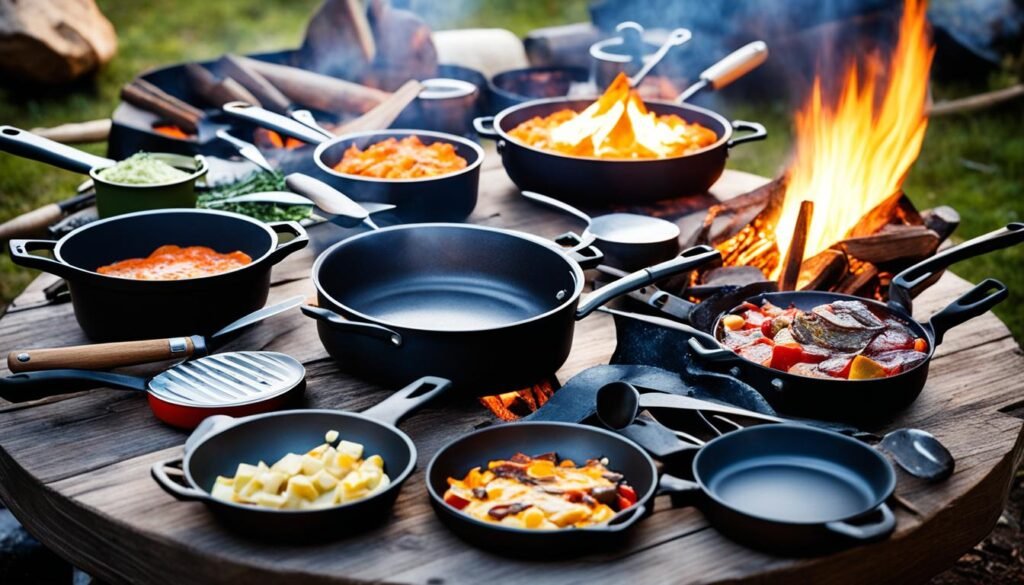
Pre-Campfire Meal Prep Tips
With the echo of wildlife amidst the trees, you will want to minimize the fuss and maximize enjoyment. The cornerstone of easy campfire recipes is effective prep. At home, engage in some culinary foreplay by roasting your choice mix of peppers over a direct flame. Char them to perfection and steam in a sealed container—a method that will reward you with a smoky depth once at camp. Chopping onions and carrots can be done in the comfort of your kitchen, alongside the blending of dry spices like paprika, ancho chile, and garlic powder. Such meticulous preparation allows the potent essence of these spices to penetrate the heart of your campfire chili recipe.
Meat, the soul of your chili, benefits from pre-camp attention too. Trim and cube the lamb shoulder, tuck it into a ziplock bag, and give your chorizo a place among your provisions. And let’s not forget the beans –black and kidney – rinsed and ready to join the symphony of flavors. A tipple of a dark beer, such as a stout or brown ale, and quality beef stock should be packed with care, rounding off your list of secret ingredients.
The rewards of pre-trip kitchen labor are many, from speeding up cooking time by the campfire to reducing the cleanup demands in a campsite setting. Incorporate these outdoor cooking tips into your preparation routine, and you will elevate not just the flavor of your campfire cooking but the entire outdoor dining experience.
All these preparations culminate in the moment when you gather around the fire, conceiving a meal that is as much about the journey as the destination. And as the stars begin to dot the navy-blue canvas above, you’ll find solace in knowing that your campfire cooking techniques have set you up for success, ready to enjoy a chili that is both a masterpiece of flavor and a testament to your adventuring spirit.
How to Cook Chili Over a Campfire
Embarking on the rustic journey of a campfire chili recipe brings me back to the origins of communal cooking, where the dance of flames and embers brings not just heat, but flavor. It’s that initial crackling spark and the glow of coals that sets the scene for a culinary adventure. The key to how to cook chili over a campfire is embracing both patience and spontaneity as you craft a dish imbued with the essence of the great outdoors.
Browning the meats, I use lamb shoulder from The Heart & Trotter and chorizo, anchors the chili with a rich, smokey flavor. Marrying them with a bouquet of spices and the bold colors of freshly roasted peppers, I invite an explosion of flavors that tease the senses. Pouring in the dark beer, a stout preferably, I watch as it mingles with the crushed tomatoes and beef stock, creating a broth that promises depth and comfort.
Consult my simple yet crucial step-by-step guide, capturing the essence of campfire cooking:
- Ignite your campfire, and let it burn down to hot, glowing coals suitable for cooking.
- Place your Dutch oven amidst the coals to preheat, preparing it for the ingredients to come.
- Mix your lamb chunks with flour in a bag and shake to coat evenly—this technique seals in juiciness and provides a tempting caramelization.
- Add oil or butter to the preheated Dutch oven before ushering in your meat, browning each cube to perfection.
- Invite the chorizo into the mix, stirring until it’s fully cooked and infused into the other ingredients.
- Unveil your mason jar of prepped aromatics and spices, casting them into the Dutch oven to sauté, thus awakening their vibrant flavors.
- Pour in your carefully selected beer, followed by the crushed tomatoes and beans, to lay the foundation of your chili’s liquid component.
- Sprinkle in salt and pepper to taste, as you adjust seasoning to personal preference.
- Cover the Dutch oven and allow your chili to slow-cook over the coals, maintaining a gentle bubble—about 2 hours of occasional stirring.
- Prop the lid slightly ajar—not only does it let the chili breathe, it keeps out the curious critters drawn by the enthralling aroma.
Completing this process embodies the campfire cooking techniques that date back to times when the open flame was all our ancestors had. It’s more than food; it’s a narrative of survival, culture, and community told through a simmering pot of chili. After hours beside the fire, the chili transforms into a testament to your patience and skill. Serve over cornbread or a bed of potatoes, and you’ve got yourself a meal that echoes the rich character of outdoor living.

Whether you’re settled under the canopy of towering trees or gazing up at star-punctured skies, cooking campfire chili is as much about the experience as it is about the meal. So gather round, ladle the fruit of your labor into bowls, and bask in the joy of flavors that can only be achieved with embers and time.
Campfire Cooking Techniques for the Perfect Chili
As the stars begin to twinkle overhead, the real magic happens in the coals beneath our Dutch oven, where the robust flavors of our campfire chili come to life. It’s here, in the heart of the wilderness, where my expertise in campfire cooking techniques is put to the test. Each step, from managing the heat to the gentle simmer, contributes to a chili that’s rich in flavor and steeped in the essence of outdoor cooking.
Managing Heat and Coals
One of the most pivotal outdoor cooking tips I’ve learned is the importance of heat control. To transform raw ingredients into a savory masterpiece, we must allow the campfire to mature into a bed of coals that radiates even, gentle heat. This bed of coals is where the chili will cook slowly, developing flavors that are as deep and complex as the forest around us.
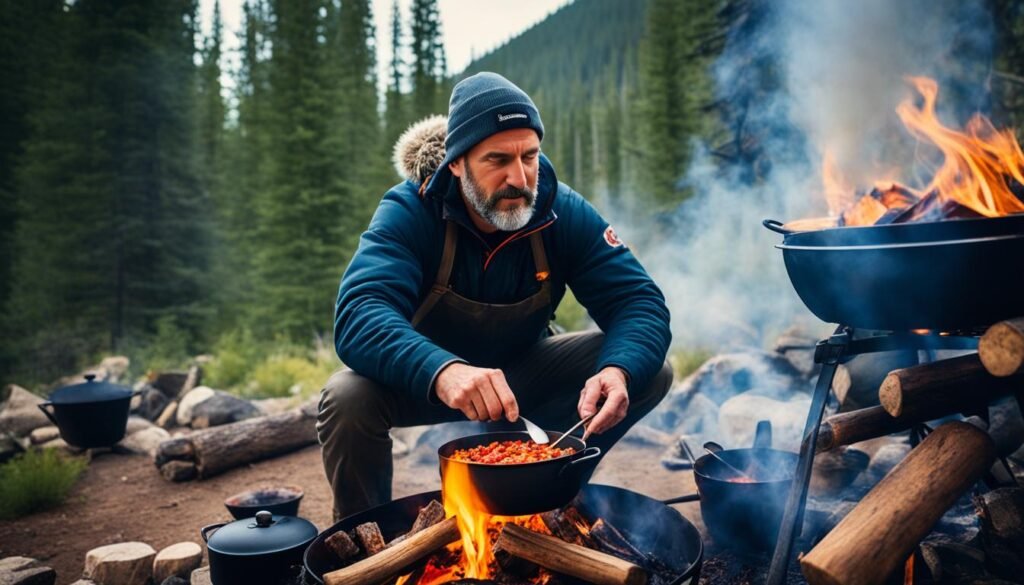
Managing the heat begins long before the first spice is added to the pot. The fire must be built with patience, letting it breathe and grow. Then, as it reduces to glowing embers, it’s time to nestle the Dutch oven in place, ready for the culinary journey ahead. The goal is to maintain a consistent temperature, much like a slow cooker back home, but with the added benefit of the smoky notes only nature can provide.
Stirring and Simmering: Keys to Great Campfire Chili
To know how to cook chili over a campfire is to understand the art of the stir. A chili’s heart and soul lie in the melding of its flavors, which is why I continuously attend to the pot, stirring gently to prevent sticking and ensure a harmonious blend. The act of stirring doesn’t just mix ingredients; it’s a ritual that connects me with each element within the pot.
Simmering is a slow dance—the cover slightly ajar, the chili breathes and thickens as hours pass by. Yet attention to the flames must not waver. A proactive approach, adding just the right amount of wood at the right time, keeps the fire alive and the heat steady, ensuring that the chili develops its rich flavors without rushing. It’s these moments, tending to the pot and the fire, that make campfire chili not merely a meal, but an experience to be savored.
- The foundation of great campfire chili is a consistent heat source.
- Stirring is crucial for even flavor development and to prevent the chili from sticking to the pot.
- Simmering allows the flavors to meld together, creating a more cohesive and richer taste.
As I stand by the fire, guiding the chili on its slow journey to perfection, it’s clear that campfire cooking is as much an art as it is a method. With these techniques at your disposal, you can create not just a dish, but a delicacy that embodies the spirit of adventure and the solace of nature. This is campfire cooking, where every spoonful is a story—and one that I’m proud to share by the flicker of flames.
Best Chili for Camping: Flavorful and Filling
As I gather kindling and logs for tonight’s campfire, my mind is set on creating the best chili for camping—a comforting, rich dish that’s become a tradition on my outdoor escapes. The key to a memorable rustic chili recipe lies not just in its heartwarming ability to fill the belly, but also in its blend of bold flavors that can stand up to the rusticity of the open flames.
Why the Blend of Spices Matters
My campfire chili recipe is where I can truly play with flavors. Spices are the soul of the chili, and their selection is paramount. A thorough blend of paprika, ancho chile powder, and garlic powder act as the building blocks, imparting warmth, a hint of smoke, and a rustic earthiness, resonant of the untamed outdoors. Each spice is chosen carefully to enhance the medley of flavors, creating that ultimate bowl of chili that seems to embrace you from within with every spoonful.
The Importance of Quality Meats and Produce
To create the most flavorful and fulfilling chili, I rely on top-quality meats and produce, which serve as the backbone to my renowned dish. The lamb shoulder and chorizo, sourced from local butchers like The Heart & Trotter, contribute a complex savory base, while fresh vegetables like onions and carrots, chopped finely and folded into the mix, maintain their integrity and offer a balance to the richness of the meats. This combination of top-tier staples elevates the dish from a mere campfire meal to a fine example of outdoor cuisine.
The confluence of spices and high-quality ingredients guarantees that every spoonful of this heartwarming chili is brimming with flavor. Even as it cooks slowly by the campfire, one can’t help but salivate at the harmony of flavors developing under the starlit sky—a true testament to the rewarding nature of cooking in the wild.
Each encounter with nature calls for delicious campfire meals, a union of simplicity and taste that underscores the beauty of our surroundings. There’s an undeniable satisfaction in tucking into a homemade chili while recounting the day’s adventures. The rich and satisfying concoction provides not just sustenance, but a sensory journey that’s the epitome of campsite dining. Thus, a rustic chili recipe becomes not just food, but a centerpiece in the narrative of my camping expeditions.
Delicious Campfire Meals: Complementing Your Chili
As the essence of my rustic chili recipe wafts through the campsite, I find myself contemplating the perfect complements to this quintessential campfire bounty. In the spirit of simplicity and tradition, I focus on easy campfire recipes for sides that not only enhance the hearty chili but also align with the principles of straightforward, delightfully rustic fare.
No-Fuss Sides: Cornbread and Potatoes
The art of creating delicious campfire meals is often found in the balance of flavors and textures. For my chili, nothing pairs better than the crumbly sweetness of cornbread or the earthy softness of baked potatoes. Each adds a unique dimension, absorbing and mingling with the chili’s robust sauce while providing a delightful contrast in texture that complements the main dish. Cornbread, with its golden crust and tender crumb, offers a touch of sweetness that harmonizes with the chili’s heat. On the other hand, the potatoes, with their flaky skins and buttery interiors, become vessels for the zesty chili, creating an effortlessly rustic and satisfying meal.
Pairings for a Gourmet Wilderness Experience
Matching the rugged environment of the great outdoors with a nuanced dining experience, I pair my chili with a selection that elevates the meal beyond typical campfire fare. A chilled craft beer, like a robust stout or a refreshing brown ale, enhances the deep flavors of the chili, creating a symphony of taste that celebrates the wilderness setting. For those who favor the vine over the hops, a glass of full-bodied wine, perhaps a malbec or zinfandel, complements the earthy, spicy notes of the dish, enveloping the palate in a luxurious blend of warmth and complexity. This gourmet touch, incorporating the pairing of beverage and meal, ushers a moment of culinary refinement into the campfire dining experience.
As I sit back and admire the harmony of my campfire spread, I recognize that in these choice pairings and simple sides, the rustic chili recipe takes on new life. The wilderness is more than just a backdrop—it’s an active participant in the meal, its untamed beauty reflected in every bite of this feast crafted beneath the open sky.
Outdoor Cooking Tips: Ensuring Safe and Enjoyable Experience
Delving into the open wilderness, I’ve learned that outdoor cooking tips are as crucial as the ingredients themselves when it comes to whipping up a flavorful chili by a campfire. It’s not simply about knowing how to cook chili over a campfire, but also about creating a safe and delightful environment that lets everyone enjoy the process as much as the dish itself.
Take it from me, food safety takes center stage in the great outdoors. Keeping a tidy campsite and being meticulous about food handling can make or break your experience, not to mention prevent a curious bear from joining your feast. Moreover, abiding by fire safety regulations keeps your cooking adventure from turning into a wildfire news headline.
I’ve put together a comprehensive checklist incorporating essential campfire cooking techniques and precautions—a primer to guide your culinary explorations amidst nature.
- Clean as You Go: Adequate garbage disposal and cleaning resources will help keep wild animals at bay.
- Fire Safety Mastery: Understand how to build, maintain, and extinguish a campfire properly to ensure that it remains a source of comfort, not danger.
- Ingredient Integrity: Store your food at correct temperatures using coolers and ice packs to keep your ingredients fresh and safe.
- Tool Readiness: Have all the necessary cooking utensils and safety gear at hand to avoid last-minute hassles.
Practicing these fundamental outdoor cooking tips ensures a preservation of both nature’s sanctity and our personal wellbeing.
| Outdoor Cooking Element | Tips for Safety | Tips for Enjoyment |
|---|---|---|
| Campsite Cleanliness | Use bear-proof containers and dispose of waste properly. | A clutter-free site provides a more serene cooking environment. |
| Fire Management | Keep a bucket of water or sand nearby for emergencies. | A well-maintained fire provides consistent cooking heat. |
| Food Storage | Chill perishables and seal food items to prevent spoilage. | Well-preserved ingredients enhance the flavor of your meals. |
| Equipment Checklist | Ensure first aid and fire extinguishers are easily accessible. | Pre-assembled gear makes setting up the cooking area smoother. |
Equipped with this knowledge and a spirit of adventure, you’re now more than ready to tackle the wild and make memories that are flavored with not just spice, but also safety and joy.
Sharing the Warmth: Campfire Chili Variations and Sharing with Friends
There’s a special kind of joy that comes with gathering around a campfire, sharing stories, laughter, and good food. This campfire chili recipe is more than a simple meal; it’s a catalyst for companionship and the sharing of warmth in the great outdoors. The communal pot of chili, simmered over an open flame, becomes the centerpiece of our wilderness banquet.
Adapting the Recipe for Various Tastes
What makes this campfire chili recipe truly special is its adaptability. As each camper brings their own palate to the wilderness, the recipe can be attuned to suit everyone’s taste. For those who adore heat, additional jalapeños and a pinch more of ancho chile powder can set the tongue tingling. Conversely, others might favor a milder version, where bell peppers shine and the spicier elements are curtailed.
For friends with dietary needs, there are easy substitutions that ensure they too can enjoy the smoky allure of chili cooking over open flame. Exchange the lamb for a plant-based protein for vegetarians, or swap in turkey for those watching red meat intake. The essence of campfire chili is its robust foundation; everything else can be tailored to create an inviting bowl for each individual around the fire.
The Joy of Sharing Food in the Wild
The moments spent how to cook chili over a campfire are about more than sustenance; they’re about cementing relationships. Every spoonful passed from hand to hand, every satisfied sigh as the heat takes the evening chill away, strengthens the sense of community. In each shared experience, bonds are formed and memories are made—spiced with laughter, the glow of the campfire, and, of course, the flavorful depth of a well-crafted chili.
I relish the ritual as much as the feast itself—inviting each friend to stir the pot, contribute an ingredient, or simply tell a tale that casts a spell over the simmering chili. This is campfire cooking as it should be: a venture not into just preparing food, but into weaving a shared story.
So, here’s to the chilly nights warmed by firelight and friendship, to the hearty feasts that fuel our outdoor endeavors, and to the rustic pots of chili that somehow taste better when the sky is the roof and the earth is the seat. This is more than a meal; it’s a tradition that continues to nourish the soul long after the last embers have faded into dawn.
Conclusion
As the campfire dwindles to glowing whispers, my thoughts collect around the days spent nestled in nature’s cradle, zealously engaging in an ancient culinary dance. Here, to cook chili over a campfire is to partake in a tradition that reaches back to when fire itself was new. It’s an experience that melds the delights of a simple meal with the grandeur of the open sky, a harmonious confluence that illumines the very essence of campfire cooking.
Reflections on a Memorable Campfire Chili Experience
My sojourns into the wild are punctuated by the hearty aromas of campfire chili — a dish that has become a personal totem of wilderness freedom. Employing campfire cooking techniques, I’ve transformed basic ingredients into a sumptuous feast that serves not just the body, but the soul. Each simmering batch is a reminder of the kinship shared with fellow adventurers, a culinary ritual that fosters enduring bonds. This rustic chili has transcended its role as sustenance to become the centerpiece of many an unforgettable night.
Encouraging Others to Try Cooking Over an Open Flame
I beckon fellow outdoor enthusiasts to embrace the primal artistry that is campfire cuisine. The allure of casting iron into the flames, the gratification of stirring a pot that tells a story — these experiences beckon with unspoken richness. Whether a seasoned camper or a novice to the embers, the journey of crafting a meal in the wild is a profound delight that awaits all. With the right outdoor cooking tips, anyone can transform a simple fire into a banquet hall under the stars.
In the end, it’s about more than the food; it’s about reliving a fundamentally human tradition, one where the flame is a shared hearth and the meal, a shared treasure. I invite you to lose yourself in this timeless ritual and to discover, as I have, the pure satisfaction of a chili night under the canopy of the cosmos.
FAQ
How do I prepare chili ingredients before heading out to my camping trip?
To streamline your campfire cooking, do as much preparation at home as possible. You can dice vegetables, measure out spices, and store everything in sealable containers. You should brown your meats and chill them for travel, but make sure everything is well-packaged to avoid spills and spoilage during transport to your campsite.
What equipment do I need to cook chili over a campfire?
The most important piece of equipment you’ll need is a sturdy, cast-iron Dutch oven, which can withstand the heat of a campfire. You will also need fireproof kitchen tools like a wooden spoon or ladle for stirring, a pair of heat-resistant gloves for safety, and a tight-fitting lid for your pot to retain heat and flavors while cooking.
Can you share tips for managing the campfire while cooking chili?
Absolutely! Start your campfire early and let it burn down to a stable bed of coals; this will provide a consistent heat source. Keep some firewood or charcoal on hand to maintain the heat as needed, and remember to regulate the fire size given environmental conditions and safety considerations. The goal is a slow simmer, not a vigorous boil.
Why is chili considered the best meal for camping?
Chili is hearty, filling, and versatile – you can adapt it to suit any taste. It provides plenty of protein and carbs for energy, it’s relatively easy to cook, and it warms you up on cooler nights. The communal aspect of sharing a comforting pot of chili also helps to create a cozy, convivial atmosphere.
What makes a Dutch oven ideal for campfire chili?
A Dutch oven is thick-walled, which allows it to distribute heat evenly, making it perfect for the fluctuating temperatures of campfire cooking. Its heavy lid seals in moisture and flavor, while the cast-iron construction stands up to the direct heat of the flames and embers, making it the go-to vessel for campfire chili and other delicious campfire meals.
How do I ensure the chili is evenly cooked over a campfire?
Stir your chili regularly to prevent burning and even out the heat distribution. If one part of your campfire is hotter, rotate the Dutch oven periodically to expose different sides to the heat. Keeping your chili at a low simmer rather than a boil is essential for even cooking and developing flavors.
What are the key ingredients for a rustic chili recipe?
For a rustic chili, you’ll want a mixture of hearty meats like lamb and chorizo, a variety of beans for texture, vegetables such as onions and peppers for depth of flavor, and a blend of spices including ancho chile powder and paprika. Dark beer and beef stock are preferred liquids that add richness, while crushed tomatoes round out the base.
Can I adapt my campfire chili for different dietary preferences?
Definitely! You can make vegetarian chili by omitting the meat and adding more beans or possibly textured vegetable protein. To accommodate spice preferences, adjust the amount and type of chili powder or fresh peppers. For a gluten-free version, be sure to use gluten-free beer or substitute with a gluten-free broth.
How can I make outdoor cooking a safe and enjoyable experience?
To ensure safety and enjoyment while cooking outdoors, always maintain a clean cooking area, keep perishables in a cooler, and be aware of local wildlife—secure your food to avoid attracting animals. Be conscious of fire safety, keeping water or a fire extinguisher nearby, and make sure to fully extinguish the fire when you’re finished cooking.
What can I serve with chili to enhance the campfire dining experience?
Rustic sides like cornbread and baked potatoes are fantastic with chili, as they complement its heartiness and soak up the rich sauce. For a touch of luxury outdoors, pair your chili with a craft beer selected to match the chili’s robust flavors, or choose a wine that can hold up to the spices.

